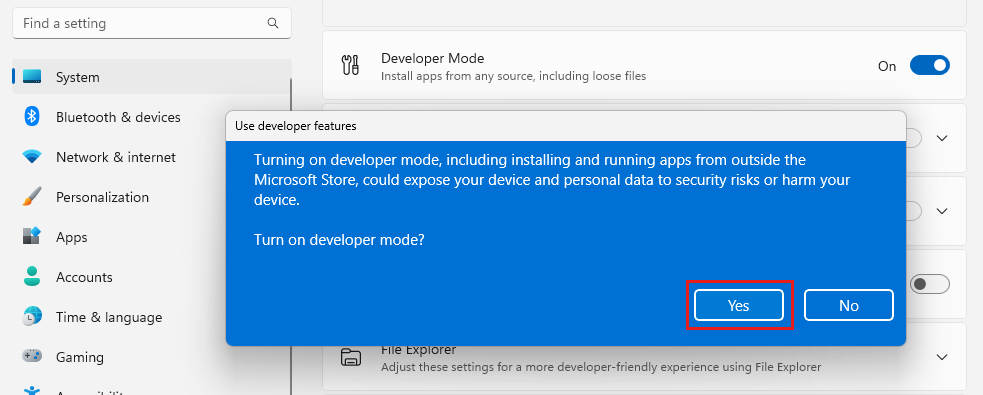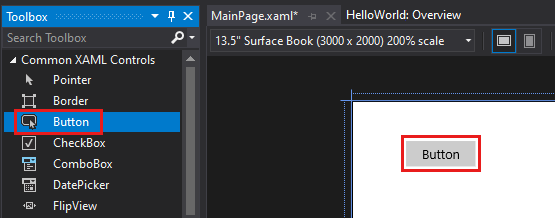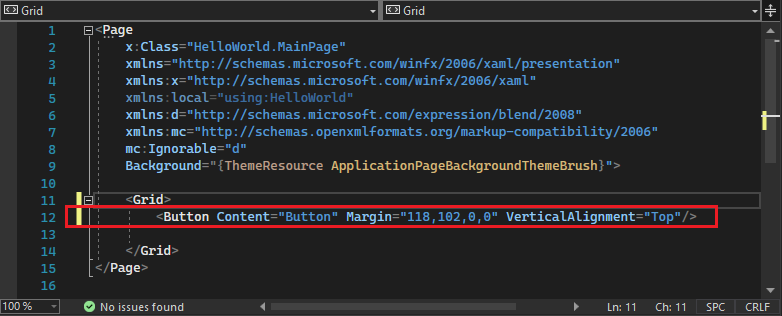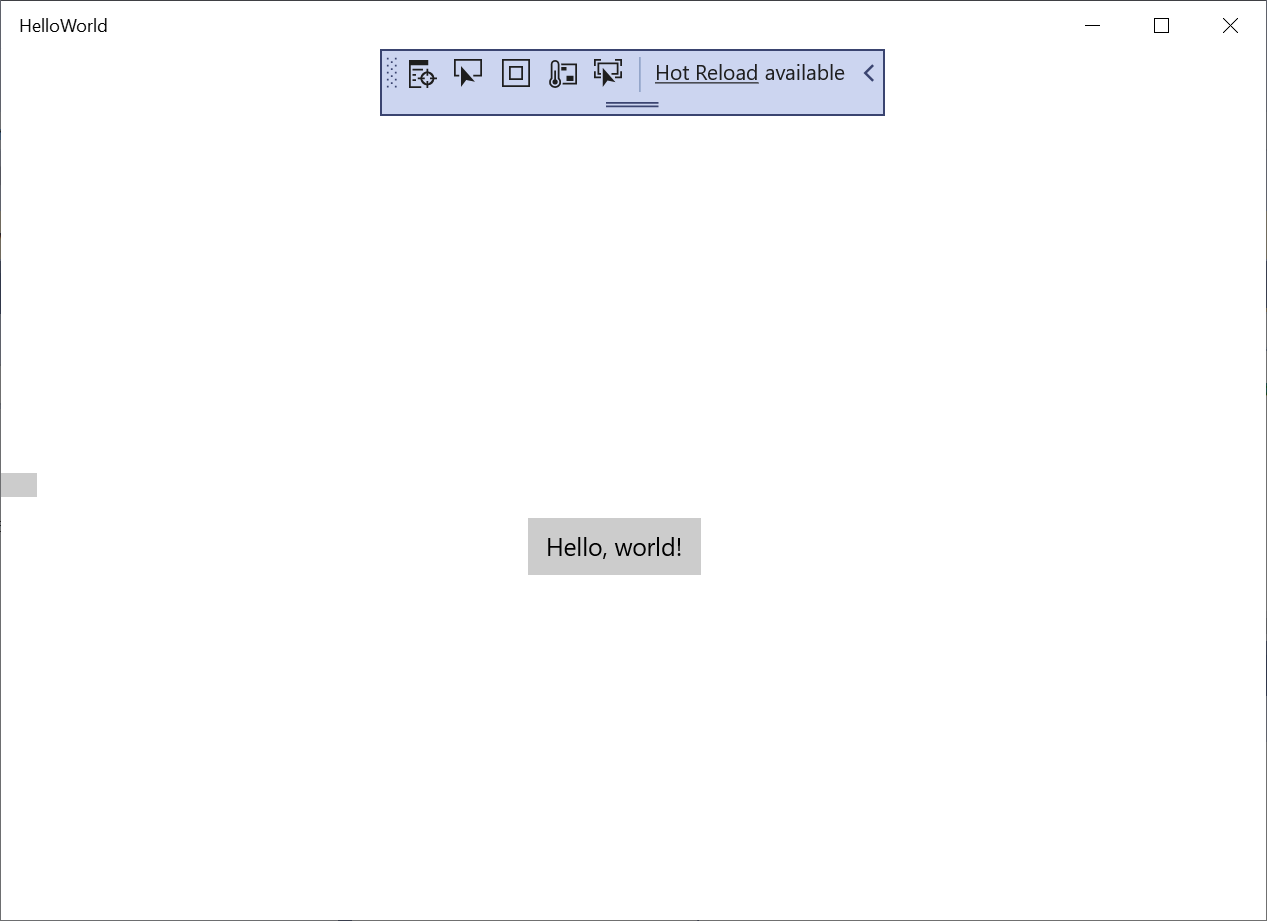Tutorial: Create your first Universal Windows Platform application in Visual Studio with XAML and C#
In this tutorial, as an introduction to the Visual Studio integrated development environment (IDE), you create a "Hello World" app that runs on any Windows 10 or later device. To do so, you use a Universal Windows Platform (UWP) project template, Extensible Application Markup Language (XAML), and the C# programming language.
Note
If you're happy with your current functionality in the Universal Windows Platform (UWP), then there's no need to migrate your project type to Windows App SDK. WinUI 2.x, and the Windows SDK, support UWP project types. If you would like to get started with WinUI 3 and Windows App SDK, then you can follow the steps in the Windows App SDK tutorial.
In this tutorial, you:
- Create a project
- Create an application
- Run the application
Prerequisites
You need Visual Studio to complete this tutorial. Visit the Visual Studio downloads page for a free version.
Note
This tutorial requires the Blank App (Universal Windows) project template. During installation, select the Universal Windows Platform development workload:

If you already have Visual Studio installed and need to add it, from the menu, select Tools > Get Tools and Features, or in the Create a new project window, select the Install more tools and features link.

Create a project
First, create a Universal Windows Platform project. The project type comes with all the template files you need, before you even add anything!
Open Visual Studio, and on the start window, choose Create a new project.
On the Create a new project screen, enter Universal Windows in the search box, choose the C# template for Blank App (Universal Windows), and then choose Next.

Give the project a name, HelloWorld, and choose Create.

Accept the default Target version and Minimum version settings in the New Universal Windows Platform Project dialog box.

Note
If this is the first time you have used Visual Studio to create a UWP app, a Settings dialog box might appear. Choose Developer mode, and then choose Yes.

Visual Studio installs an additional Developer Mode package for you. When the package installation is complete, close the Settings dialog box.
Open Visual Studio, and on the start window, choose Create a new project.
On the Create a new project screen, enter Universal Windows in the search box, choose the C# template for Blank App (Universal Windows), and then choose Next.

Give the project a name, HelloWorld, and choose Create.

Accept the default Target version and Minimum version settings in the New Universal Windows Platform Project dialog box.

Note
If this is the first time you have used Visual Studio to create a UWP app, the Enable Developer Mode for Windows dialog box appears. Select settings for developers to open Settings. Turn on Developer mode, and then choose Yes.

Visual Studio installs an additional Developer Mode package for you. When the package installation is complete, close the Settings dialog box.
Create the application
It's time to start developing. Add a button control, add an action to the button, and then start the "Hello World" app to see what it looks like.
Add a button to the Design canvas
In the Solution Explorer, double-click
MainPage.xamlto open a split view.
There are two panes: The XAML Designer, which includes a design canvas, and the XAML Editor, where you can add or change code.

Choose Toolbox to open the Toolbox fly-out window.

If you don't see the Toolbox option, you can open it from the menu bar. To do so, choose View > Toolbar. Or, press Ctrl+Alt+X.
Select the Pin icon to dock the Toolbox window.

Select the Button control and then drag it onto the design canvas.

If you look at the code in the XAML Editor, you see that the Button appears there, too:

In the Solution Explorer, double-click
MainPage.xamlto open a split view.
There are two panes: The XAML Designer, which includes a design canvas, and the XAML Editor, where you can add or change code.

Choose Toolbox to open the Toolbox fly-out window.

If you don't see the Toolbox option, you can open it from the menu bar. To do so, choose View > Toolbar. Or, press Ctrl+Alt+X.
Select the Pin icon to dock the Toolbox window.

Select the Button control and then drag it onto the design canvas.

If you look at the code in the XAML Editor, you see that the Button appears there, too:

Add a label to the button
In the XAML Editor, change
Button Contentvalue from Button to Hello World!
Notice that the button in the XAML Designer changes, too.

In the XAML Editor, change
Button Contentvalue from Button to Hello World!
Notice that the button in the XAML Designer changes, too.

Add an event handler
An event handler sounds complicated, but it's just another name for code that is called when an event happens. In this case, it adds an action to the Hello World! button.
Double-click the button control on the design canvas.
Edit the event handler code in MainPage.xaml.cs, the code-behind page.
Here's where things get interesting. The default event handler looks like this:

Change it, so it looks like this:

Here's the code to copy and paste:
private async void Button_Click(object sender, RoutedEventArgs e) { MediaElement mediaElement = new MediaElement(); var synth = new Windows.Media.SpeechSynthesis.SpeechSynthesizer(); Windows.Media.SpeechSynthesis.SpeechSynthesisStream stream = await synth.SynthesizeTextToStreamAsync("Hello, World!"); mediaElement.SetSource(stream, stream.ContentType); mediaElement.Play(); }
Double-click the button control on the design canvas.
Edit the event handler code in MainPage.xaml.cs, the code-behind page.
Here's where things get interesting. The default event handler looks like this:

Change it, so it looks like this:

Here's the code to copy and paste:
private async void Button_Click(object sender, RoutedEventArgs e) { MediaElement mediaElement = new MediaElement(); var synth = new Windows.Media.SpeechSynthesis.SpeechSynthesizer(); Windows.Media.SpeechSynthesis.SpeechSynthesisStream stream = await synth.SynthesizeTextToStreamAsync("Hello, World!"); mediaElement.SetSource(stream, stream.ContentType); mediaElement.Play(); }
What did we just do?
The code uses some Windows APIs to create a speech synthesis object and then gives it some text to say. For more information on using SpeechSynthesis, see System.Speech.Synthesis.
Run the application
It's time to build, deploy, and launch the "Hello World" UWP app to see what it looks and sounds like. Here's how.
Use the Play button to start the application on the local machine. It has the text Local Machine.

Alternatively, you can choose Debug > Start Debugging from the menu bar or press F5 to start your app.
View your app, which appears soon after a splash screen disappears. The app should look similar to this figure:

Select the Hello World button.
Your Windows 10 or later device literally says, "Hello, World!"
To close the app, select the Stop Debugging button in the toolbar. Alternatively, choose Debug > Stop debugging from the menu bar, or press Shift+F5.
It's time to build, deploy, and launch the "Hello World" UWP app to see what it looks and sounds like. Here's how.
Use the Play button (it has the text Local Machine) to start the application on the local machine.

Alternatively, you can choose Debug > Start Debugging from the menu bar or press F5 to start your app.
View your app, which appears soon after a splash screen disappears. The app should look similar to this image:

Select the Hello World button.
Your Windows 10 or later device literally says, "Hello, World!"
To close the app, select the Stop Debugging button in the toolbar. Alternatively, choose Debug > Stop debugging from the menu bar, or press Shift+F5.
Related content
Next step
Congratulations on completing this tutorial! We hope you learned some basics about UWP and the Visual Studio IDE. To learn more, continue with the following tutorial: